Will Pfeifer's Blog, page 40
July 23, 2012
From the Bookshelves: 'Lucky Wander Boy'
Third in a series of random, rambling explorations of my library.
There's a lot of love online for Ernest Cline's 2011 videogame novel "Ready Player One," and it's a fun book to be sure, but for my money, the best novel inspired by the ever-shifting reality of vintage videogames is "Lucky Wander Boy," a smart, sophisticated and subtle bit of fiction by D.B. Weiss that was first published back in 2003.
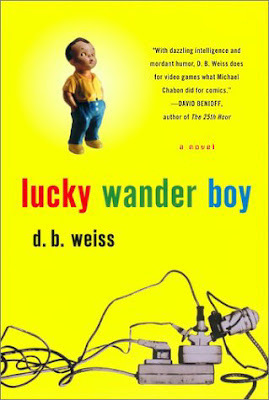
Weiss' novel focuses on a typically hapless and aimless pop culture-obsessed Gen-Xer named Adam Pennyman who is writing a tome called "The Catalog of Obsolete Entertainments" that he hopes will offer astute analysis of every videogame ever made. We see glimpses of the work in project in "Lucky Wander Boy," and Adam's analysis is pretty damned astute, with an intriguing bit about the half-second disappearance Pac Man makes when going from one side of the screen symbolizing the mystery and wonder of the best games.
But when Adam learns of Lucky Wander Boy, a forgotten game that might be nothing but rumors, he becomes obsessed with it, letting the idea of its Eastern philosophy-based structure take over most of his life. "Lucky Wander Boy" has loads of great pop culture references, including a funny, fascinating retelling of the legendary debacle behind the release of Atari's much-anticipated "E.T." game. But in its later chapters, and during its best moments, it shifts gears from merely checking off pop cult boxes (which, if you ask me, "Ready Player One" does much too much) and delves more deeply into its subject matter, exploring what it means to lose yourself in the alternate reality of a game.
It's an entertaining and thought-provoking book. The fact that it's about videogames is a bonus.
By the way, after reading "Lucky Wander Boy" years ago, I'd searched high and low for more by D.B., but I couldn't find another book and figured that this was all he'd written. Imagine my surprise when I finally got around to watching HBO's "Game of Thrones" last month and laid my eyes on the opening credits...

There's a lot of love online for Ernest Cline's 2011 videogame novel "Ready Player One," and it's a fun book to be sure, but for my money, the best novel inspired by the ever-shifting reality of vintage videogames is "Lucky Wander Boy," a smart, sophisticated and subtle bit of fiction by D.B. Weiss that was first published back in 2003.

Weiss' novel focuses on a typically hapless and aimless pop culture-obsessed Gen-Xer named Adam Pennyman who is writing a tome called "The Catalog of Obsolete Entertainments" that he hopes will offer astute analysis of every videogame ever made. We see glimpses of the work in project in "Lucky Wander Boy," and Adam's analysis is pretty damned astute, with an intriguing bit about the half-second disappearance Pac Man makes when going from one side of the screen symbolizing the mystery and wonder of the best games.
But when Adam learns of Lucky Wander Boy, a forgotten game that might be nothing but rumors, he becomes obsessed with it, letting the idea of its Eastern philosophy-based structure take over most of his life. "Lucky Wander Boy" has loads of great pop culture references, including a funny, fascinating retelling of the legendary debacle behind the release of Atari's much-anticipated "E.T." game. But in its later chapters, and during its best moments, it shifts gears from merely checking off pop cult boxes (which, if you ask me, "Ready Player One" does much too much) and delves more deeply into its subject matter, exploring what it means to lose yourself in the alternate reality of a game.
It's an entertaining and thought-provoking book. The fact that it's about videogames is a bonus.
By the way, after reading "Lucky Wander Boy" years ago, I'd searched high and low for more by D.B., but I couldn't find another book and figured that this was all he'd written. Imagine my surprise when I finally got around to watching HBO's "Game of Thrones" last month and laid my eyes on the opening credits...
Published on July 23, 2012 06:00
July 22, 2012
Will Elder Weekends: Goodman Meets S*perm*n
Here's a classic Will Elder splash page from "Goodman Meets S*perm*n," the Superman (of course) parody from the second issue of HELP (May 1962) with script from Harvey Kurtzman (again, of course).
It never hits the heights of manic genius that Harvey and Wally Wood's "Superduperman!" did back in MAD #4, mostly because this one is a low-key affair, focusing on our hero, Goodman Beaver, encountering S*perm*n living a life of anonymity, hidden behind his Clark Kent glasses and a full beard. believing that people aren't worth the trouble. Ever the innocent, Goodman (Kurtzman's Candide figure) tries to prove him wrong and, of course, fails miserably. The end. (Oh, and spoilers, I guess, for a 50-year-old story.)
Elder's art is the main reason to pay attention here, with him hitting peak levels of detail and jokes-per-square-inch. And, of course, Elder being Elder, it's all beautifully rendered and perfectly easy to understand. The man was a master.
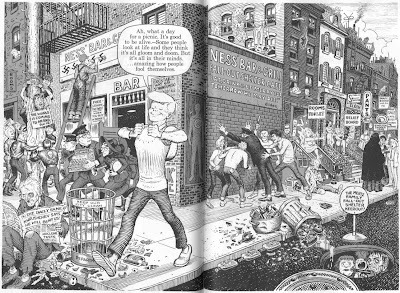
Trust me, this is one image you really need to click on to appreciate. And if you want to read the entire story, click here.

It never hits the heights of manic genius that Harvey and Wally Wood's "Superduperman!" did back in MAD #4, mostly because this one is a low-key affair, focusing on our hero, Goodman Beaver, encountering S*perm*n living a life of anonymity, hidden behind his Clark Kent glasses and a full beard. believing that people aren't worth the trouble. Ever the innocent, Goodman (Kurtzman's Candide figure) tries to prove him wrong and, of course, fails miserably. The end. (Oh, and spoilers, I guess, for a 50-year-old story.)
Elder's art is the main reason to pay attention here, with him hitting peak levels of detail and jokes-per-square-inch. And, of course, Elder being Elder, it's all beautifully rendered and perfectly easy to understand. The man was a master.

Trust me, this is one image you really need to click on to appreciate. And if you want to read the entire story, click here.
Published on July 22, 2012 13:05
July 19, 2012
Woo hoo! Here's the first full trailer for Paul Thomas Anderson's 'The Master'
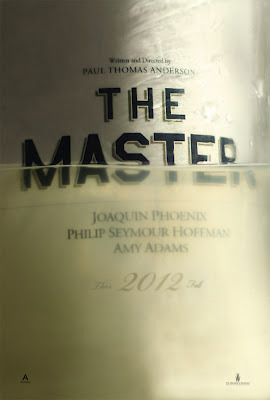
I can't think of another director with as perfect a batting average as Paul Thomas Anderson, unless it's the unrelated Wes with the same last name. But seeing as how we've already seen the latest film from Wes Anderson, "Moonrise Kingdom" -- and a damned fine film it is -- it's time to shift our attention to the Anderson film we haven't seen yet -- P.T.'s "The Master."
It's the story of a troubled young man (Joaquin Phoenix) and a guru/writer (Philip Seymour Hoffman) who shows him the way through an organization (did I hear the word "cult" in the trailer?) that he's started in the years after World War II. Obviously, there's some sort of tie to Scientology, though whether it's explicit or not we can't say ... yet. That's one reason the movie is so intriguing (with extra bonus intrigue for the fact that a certain well-known proponent of Scientology earned an Oscar nod for his performance in P.T. Anderson's 1999 film, "Magnolia").
But what's really intriguing, of course, is the fact that this is the latest film from the visionary (the term seems to apply, don't you think?) who brought us -- deep breath now -- "Hard Eight," "Boogie Nights," "Magnolia," "Punch-Drunk Love" and "There Will Be Blood." I can only imagine what he's got up his sleeve next. Here's the trailer, which looks frankly spectacular.
"The Master" opens in theaters Oct. 12.
Published on July 19, 2012 20:14
July 15, 2012
Will Elder Weekends: Will Elder News!
Hoo boy! Announced this week at the big Comic Con in San Diego is the news that coming this December in the IDW Artist Edition series is none other than a collection of work from MAD.
Here's what the story at Comic Book Resources has to say:
"You can't really say how much this is a Harvey Kurtzman book. Kurtzman developed "MAD" and nurtured it the same way he did his war titles. Many of the stories were written by Kurtzman. There will also be a stunning selection of "Mad" covers, and even some roughs in the book," [says editor Scott Dunbier]
Additionally, the "MAD: Artist's Edition" features work by the amazing cartoonists that graced the early days of the comic, including Wally Wood, Jack Davis, Basil Wolverton and Bill Elder.
Here's an image than ran with the article, showing the original art for the Kurtzman/Wood story "Batboy and Rubin!" and the Kurtzman/Elder story "Howdy Dooit!," which I'm guessing will be included in the volume...
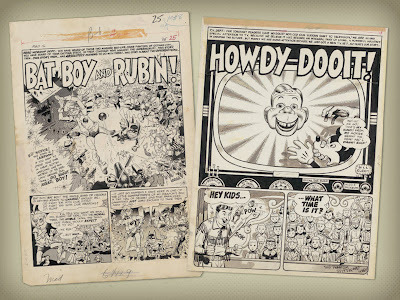
I just got my hands on the new "Daredevil: Artist Edition" that collects the entire run of the Frank Miller/David Mazzucchelli "Born Again" series, and it's an amazing volume. There's something very special about reading those pages at their original size and shot (in color) from the original art -- it feels just like flipping through the original pages themselves. I can only imagine the effect of seeing these MAD pages, which are even bigger and, I'm guessing, more elaborately rendered -- will be even more breathtaking.
It's due to hit the shelves in December, just in time for the 60th (!) anniversary of MAD.
Here's what the story at Comic Book Resources has to say:
"You can't really say how much this is a Harvey Kurtzman book. Kurtzman developed "MAD" and nurtured it the same way he did his war titles. Many of the stories were written by Kurtzman. There will also be a stunning selection of "Mad" covers, and even some roughs in the book," [says editor Scott Dunbier]
Additionally, the "MAD: Artist's Edition" features work by the amazing cartoonists that graced the early days of the comic, including Wally Wood, Jack Davis, Basil Wolverton and Bill Elder.
Here's an image than ran with the article, showing the original art for the Kurtzman/Wood story "Batboy and Rubin!" and the Kurtzman/Elder story "Howdy Dooit!," which I'm guessing will be included in the volume...

I just got my hands on the new "Daredevil: Artist Edition" that collects the entire run of the Frank Miller/David Mazzucchelli "Born Again" series, and it's an amazing volume. There's something very special about reading those pages at their original size and shot (in color) from the original art -- it feels just like flipping through the original pages themselves. I can only imagine the effect of seeing these MAD pages, which are even bigger and, I'm guessing, more elaborately rendered -- will be even more breathtaking.
It's due to hit the shelves in December, just in time for the 60th (!) anniversary of MAD.
Published on July 15, 2012 13:25
July 14, 2012
Bad Movies I Love
Be sure to check out the excellent movie blog Rupert Pupkin Speaks today and read my selections in the blog's long-running "Bad Movies We Love" series.
My picks include an '80s teen sex comedy, a women-in-prison flick, a big-budget star vehicle and, of course, Ed Wood's still-amazing piece of sci-fi/horror/folk art/home movie. Oh, and this oddity as well...

Read the rest of the series, too, for dozens of great "bad" movies that you're going to want to track down if you're anything like me. Now where did I put my DVDs of "King Frat" and "The Apple"...?
My picks include an '80s teen sex comedy, a women-in-prison flick, a big-budget star vehicle and, of course, Ed Wood's still-amazing piece of sci-fi/horror/folk art/home movie. Oh, and this oddity as well...

Read the rest of the series, too, for dozens of great "bad" movies that you're going to want to track down if you're anything like me. Now where did I put my DVDs of "King Frat" and "The Apple"...?
Published on July 14, 2012 15:03
July 10, 2012
From the Bookshelves: 'Sleazoid Express'
Second in a series of random, rambling explorations of my library.
I first visited New York City back in 1987, when Times Square was several years past "Taxi Driver" but a few years away from its current Disneyfied state. Meaning, of course, that I and my fellow midwestern college students were fascinated by all the sleaze on display.
We arrived via bus at the New York Port Authority of all places, meaning that we were dumped out right on the legendary Deuce, with most of the most notorious theaters still in operation. The days of marathon showings of kung fu epics and other R-rated obscurities were over, though, and the surviving theaters were paying their bills with -- what else? -- apparently endless screenings of plain ol' porn. My buddies and I were pleased as punch to gawk at the outsides of the theaters and pose under the marquees, but we didn't dare go inside. We were young, after all, and we wanted to live to be at least a little bit older.
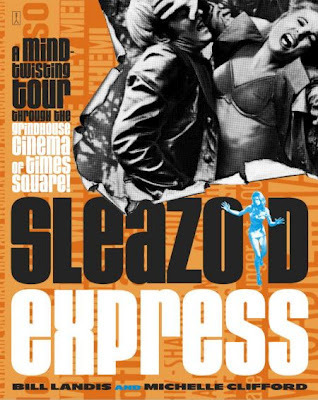
Author Bill Landis, on the other hand, did go into those theaters -- hell, he practically lived inside them for years, working the counters, watching the movies and writing about it all in his self-published 'zine, "Sleazoid Express." Landis died in 2008, but before he did, he and his wife Michelle Clifford compiled his writings in the 2002 book "Sleazoid Express: A Mind-Twisting Tour Through the Grindhouse Cinema of Times Square." I picked it up at a now-defunct Borders 10 years ago, and it's remained one of my favorite film books since then.
That's because Landis does more than simply catalog the movies that played in the pre-porn era theaters of Times Square. He structures the entire book like a travelogue of the Deuce, focusing on a theater or two in each chapter and writing about the movies that were likely to play on those screens. I'm suspicious that it broke down quite so neatly, with "race hate" (Landis' term for blaxploitation) films in one location, horror films in another and foreign oddities in a third, but I'm not complaining. It gives what could be a rambling book a solid framework and lets decades-late readers (like me) pretend they're strolling along the scum-encrusted streets of Times Square at its sleaziest.
And even with that setup, "Sleazoid Express" is a pretty rambling book, but in the best sense of the word. Landis writes about the theaters, the owners, the movies, the workers, the audience, the directors, the producers and the actors all at the same time -- sometimes, it seems, in a single sentence. It shouldn't work, but somehow it does, conveying the excitement, the uncertainty and even a bit of the danger that being a moviegoer in 1970s New York entailed. He's a very evocative writer, making you feel not only what watching a movie like, say, "Fight For Your Life" felt like back then, but what it felt like to watch it in a crumbling theater, with the crowd getting rowdier with every frame of film that spooled through the projector. It almost makes you wish for a time machine, a movie schedule and a box of popcorn. Well, almost.
As a bonus, "Sleazoid Express" acts as a handy viewer's guide for exploitation cinema. Surprisingly, virtually all the movies Landis writes about -- even obscure oddities like "Goodbye Uncle Tom," "The Candy Snatchers" and "Last House on Dead End Street" have become available on DVD since the book was published. Admittedly, it's not the same as seeing them on the big screen on the Deuce, but it's as close as we're going to get these days.
And judging by Landis' book, it's safer. A lot safer.
I first visited New York City back in 1987, when Times Square was several years past "Taxi Driver" but a few years away from its current Disneyfied state. Meaning, of course, that I and my fellow midwestern college students were fascinated by all the sleaze on display.
We arrived via bus at the New York Port Authority of all places, meaning that we were dumped out right on the legendary Deuce, with most of the most notorious theaters still in operation. The days of marathon showings of kung fu epics and other R-rated obscurities were over, though, and the surviving theaters were paying their bills with -- what else? -- apparently endless screenings of plain ol' porn. My buddies and I were pleased as punch to gawk at the outsides of the theaters and pose under the marquees, but we didn't dare go inside. We were young, after all, and we wanted to live to be at least a little bit older.

Author Bill Landis, on the other hand, did go into those theaters -- hell, he practically lived inside them for years, working the counters, watching the movies and writing about it all in his self-published 'zine, "Sleazoid Express." Landis died in 2008, but before he did, he and his wife Michelle Clifford compiled his writings in the 2002 book "Sleazoid Express: A Mind-Twisting Tour Through the Grindhouse Cinema of Times Square." I picked it up at a now-defunct Borders 10 years ago, and it's remained one of my favorite film books since then.
That's because Landis does more than simply catalog the movies that played in the pre-porn era theaters of Times Square. He structures the entire book like a travelogue of the Deuce, focusing on a theater or two in each chapter and writing about the movies that were likely to play on those screens. I'm suspicious that it broke down quite so neatly, with "race hate" (Landis' term for blaxploitation) films in one location, horror films in another and foreign oddities in a third, but I'm not complaining. It gives what could be a rambling book a solid framework and lets decades-late readers (like me) pretend they're strolling along the scum-encrusted streets of Times Square at its sleaziest.
And even with that setup, "Sleazoid Express" is a pretty rambling book, but in the best sense of the word. Landis writes about the theaters, the owners, the movies, the workers, the audience, the directors, the producers and the actors all at the same time -- sometimes, it seems, in a single sentence. It shouldn't work, but somehow it does, conveying the excitement, the uncertainty and even a bit of the danger that being a moviegoer in 1970s New York entailed. He's a very evocative writer, making you feel not only what watching a movie like, say, "Fight For Your Life" felt like back then, but what it felt like to watch it in a crumbling theater, with the crowd getting rowdier with every frame of film that spooled through the projector. It almost makes you wish for a time machine, a movie schedule and a box of popcorn. Well, almost.
As a bonus, "Sleazoid Express" acts as a handy viewer's guide for exploitation cinema. Surprisingly, virtually all the movies Landis writes about -- even obscure oddities like "Goodbye Uncle Tom," "The Candy Snatchers" and "Last House on Dead End Street" have become available on DVD since the book was published. Admittedly, it's not the same as seeing them on the big screen on the Deuce, but it's as close as we're going to get these days.
And judging by Landis' book, it's safer. A lot safer.
Published on July 10, 2012 18:40
July 8, 2012
Will Elder Weekends: Smoke the Big M!
Here's a great fake ad from Humbug that's parodying -- well, to be honest, I'm not sure what it's actually parodying, and having just returned from out of town, I don't have time to look it up. (I know, how lazy can a blogger get?) But what I do know is this is yet another great example of Elder's ability to create an ad that looks real enough until you actually take a close look at it -- then, the closer you look, the more ridiculous it becomes.
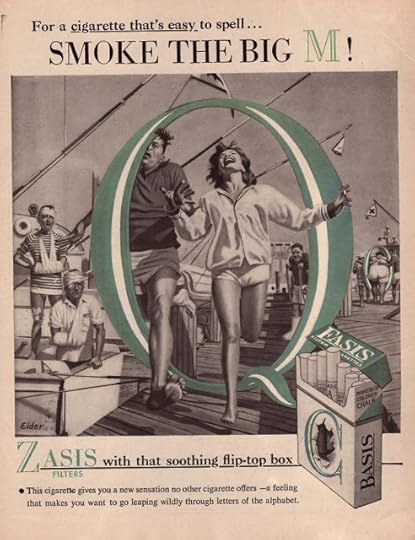
First you see the carefree expression on the woman's face... then you see the man smacking into the side of the Q. Then you notice the injured parties to the left, who obviously also walking into the letter. Then you notice that all the letters are different -- she's strolling through a Q, but the top of the ad says "Smoke the Big M!," but the copy claims they're "Zasis filter," and the box has three different letters. What's the product? Who the hell knows? And then, if you look very carefully, you see the overweight person in the distance being helped off the dock, having gotten stuck in a giant O. All that in a single fake ad. Genius!
By the way, years ago, my local comic book shop was cleaning house and I picked up a matted print of this ad for what I think was ten bucks. And it was signed by Mr. Elder himself. Nice, eh?

First you see the carefree expression on the woman's face... then you see the man smacking into the side of the Q. Then you notice the injured parties to the left, who obviously also walking into the letter. Then you notice that all the letters are different -- she's strolling through a Q, but the top of the ad says "Smoke the Big M!," but the copy claims they're "Zasis filter," and the box has three different letters. What's the product? Who the hell knows? And then, if you look very carefully, you see the overweight person in the distance being helped off the dock, having gotten stuck in a giant O. All that in a single fake ad. Genius!
By the way, years ago, my local comic book shop was cleaning house and I picked up a matted print of this ad for what I think was ten bucks. And it was signed by Mr. Elder himself. Nice, eh?
Published on July 08, 2012 16:56
July 4, 2012
It's a sad day in Mayberry. Maybe some Vitajex would pep us up a bit?
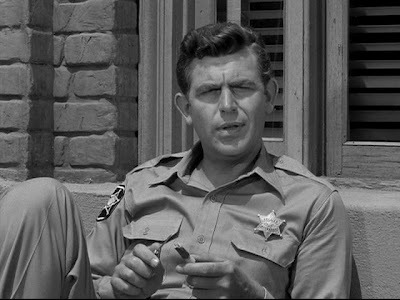
As I'm guessing you know by now, Andy Griffith has died at 86. Like just about everyone else my age, I first met him in reruns of (what else?) "The Andy Griffith show, which, before the days of Nick at Nite and TV Land, aired constantly in off hours on almost every station.
Back then, I thought it was an entertaining sitcom, sure, but nothing set it apart from the rest of the reruns in the standard lineup -- "The Beverly Hillbillies," "Gilligan's Island," "Bewitched" or "I Dream of Jeannie." But watching it now, it barely looks like the same sort of program. Quiet, contemplative and still very, very funny, "The Andy Griffith Show" is almost like a series of plays, examining the characters and conflicts of a fictional -- but oddly believable -- small Southern town. There were crazy characters, sure -- Goober, Gomer, Floyd, Ernest T. Bass, the Darlings and Barney (more on him in a bit) -- but the most memorable episodes revolved around Andy, the calm, wise center of the show, and his relationship with the others, especially his son, Opie.
Andy was wise, like I said, but he wasn't infallible. He'd make mistakes, get angry or get cocky, but then he'd admit he was wrong and do what he could to clean up the mess. I always remember the episode when Opie claimed he met a man who worked in the trees, wore a silver hat and could blow smoke out of his ears. Andy is willing to tolerate his boy's tall tales for a while, but when Opie shows up with coins and a hatchet, he demands his son tell him the truth. He even threatens to spank him unless Opie admits there is no Mr. McBeeVee, but Opie insists he exists. Andy leaves Opie's room and Barney asks if he punished Opie. Andy says no, and Barney asks if that means he believes in Mr. McBeevee. "No," Andy says, "but I do believe in Opie." Yes, it's a fictional moment on a decades-old sitcom, but that's the sort of model I hope I live up to as a father myself. (And, spoiler alert, it turns out there really was a Mr. McBeeVee. And boy, is Andy happy to see him.)
Here's the clip:
Barney Fife, of course, was the breakout character on "The Andy Griffith Show," with Don Knotts winning a whopping five Emmys for his performance. Griffith wisely saw how funny Barney could be and even more wisely conceded the spotlight to him realizing that, like other classic sitcom stars who followed (Bob Newhart, Ted Danson, Mary Tyler Moore) he was more effective -- and more funny -- reacting to Barney's shenanigans. Some of the greatest moments of "The Andy Griffith Show" were the off-the-cuff conversations they'd have about such arcane topics as stamp machines, Chinese restaurants and "brine tasters." (Here's an Onion AV Club Inventory article about those discussions.)
And, jokes aside, Andy and Barney had some memorable serious discussions, too. On at least two episodes, Barney was nervous about facing down a bigger, meaner adversary (played both times, oddly enough, by sitcom stalwart Allan Melvin), and Andy had to remind Barney that they were sworn officers of the law and deserved respect, giving Don Knotts the chance to get effectively dramatic for a change. Here's a clip from the end of "Lawman Barney":
Speaking of drama, it wasn't until years later that I saw Andy himself give one of the most blistering dramatic appearance I've seen. Before he set up shop in Mayberry, he starred in "A Face in the Crowd," a brutal 1957 fable about fame written by Budd Schulberg and directed by Elia Kazan -- and it's become one of my all-time favorite films. It co-stars Patricia Neal, Walter Matthau, Lee Remick and Tony Franciosa, but make no mistake -- this is Griffith's movie all the way. Playing Larry "Lonesome" Rhodes, a Southern scoundrel Neal discovers nursing a hangover in a small-town drunk tank, he's a terrifying portrait of what would happen if Sheriff Andy Taylor -- wise, smooth-talking, guitar-playing Sheriff Andy Taylor -- had used his powers for evil. It's an amazing performance -- funny, scary and mesmerizing, and once you've seen it, you'll never think of Andy Griffith the same way again. Here's a taste, from the movie's memorable ad campaign for Vitajex, the speed/patent medicine that sponsors Lonesome's rise to the top:
Andy Griffith did a lot of things besides "The Andy Griffith Show" and "A Face in the Crowd," of course. He starred on "Matlock," recorded hit record albums, and lent his voice to that awful sequel to "Frosty the Snowman." He even recorded that pro-Obama spot with Ron Howard for the 2008 presidential election. (He also graduated college, something 99 percent of the people on TV and movies somehow manage not to do.)
But it's this TV show and this movie that I'll always remember him for, and I'm guessing I'll be entertained and inspired (and unnerved) by the characters of Andy Taylor and Lonesome Rhodes for a long, long time.
Published on July 04, 2012 09:24
July 1, 2012
Movies I watched in June
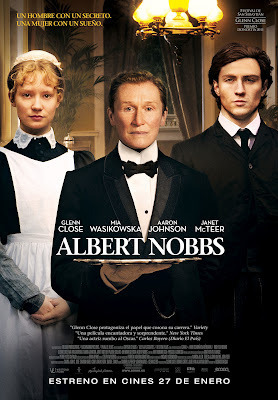
Solid acting from all involved, especially the nominated Glenn Close and Janet McTeer (even better than Close, if you ask me), but the movie doesn't have the impact it's aiming for, with too many side plots and a main character who, aside from the gender-bending, just isn't that interesting. I was shocked to realize Aaron Johnson (the guy on the right) was also the star of "Kick Ass."
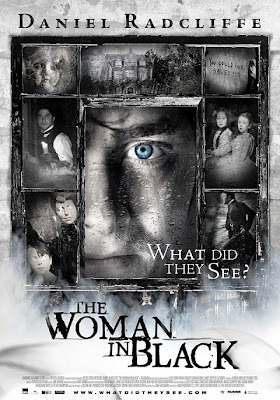
Daniel Radcliffe's much-hyped post "Potter" ghost story is loaded with atmosphere but short on actual scares. When is someone going to make a ghost story that actually gets under your skin again? Always good to see Ciaran Hinds in a movie, though. That guy's never not good.
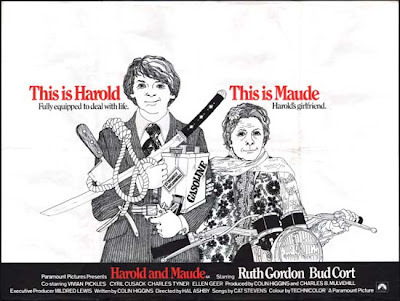
One of my favorites, and it looks better than even on the new Criterion Blu-ray. There are so many ways this movie could go so wrong, but director Hal Ashby gives everything just the right tone and Ruth Gordon's Maude avoids being the prototype for a million Manic Pixie Dream Girls. Great soundtrack, of course, too, courtesy of the former Mr. Cat Stevens. Here's my full review from the Register Star.
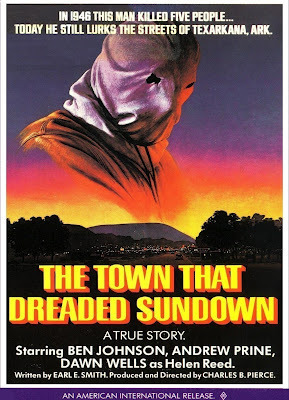
I'd heard about this one for years and finally caught it, courtesy of the fine folks at TCM. Loads of potential -- actual masked killer attacks small town in the years after World War II -- is mostly wasted thanks to listless direction and dimwitted comic relief. I kept imagining what a director like David Fincher could do with this story, giving it the treatment he gave "Zodiac." It would've been amazing.
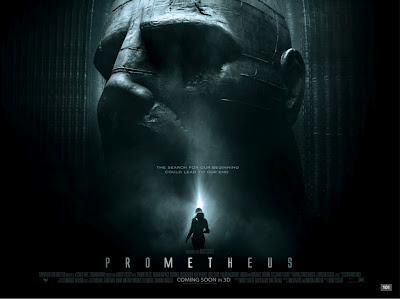
Not bad, but not up to the level of the "Alien" movies it prequels (at least the first two). And, with Ridley Scott in the director's chair, it looks spectacular. The best scene in the movie, oddly enough, doesn't involve space or even much of the way in aliens. Instead, it involves Noomi Rapace (the original "Girl in the Dragon Tattoo"), an automatic surgery contraption and an imminent birth. Wow.
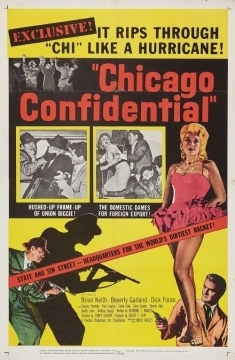
When I first came to Rockford, lo these many years ago, I scoured used bookstores and Goodwills to see what I could find in the way of oddball paperbacks. One of the volumes I stumbled upon was "Chicago Confidential," a "shocking" expose/vice guide from "journalists" Jack Lait and Lee Mortimer. This movie is allegedly based on that book, but truth is, it's just a by-the-numbers crime drama that seems amazed corruption and scandal exist at any level of politics. Plus, unlike a real Chicago classic like "Call Northside 777," it wasn't even filmed in the city. Big disappointment.
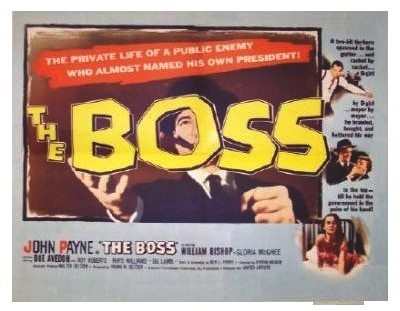
Another disappointing look at political corruption that never quite hits the mark. Maybe it's because the story skips along at an alarming (though not exciting) pace, or maybe it's because John Payne -- best known as Kris Kringle's best friend in "Miracle on 34th Street" -- is less than convincing as a supposedly ruthless political boss.
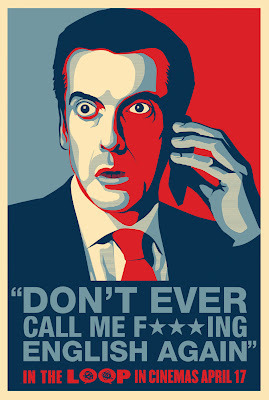
Ah, now this is more like it. Inspired by HBO's "Veep" (and repeated viewings of the other political show from creator Armando Iannucci, "The Thick of It,") I re-watched this 2009 satire that's sort of a spin-off from "The Thick of It." Fast-paced, whip-smart and full of bracingly funny -- and bracingly profane -- dialogue, it's one of the best comedies of the last decade or so. That's Peter Cipaldi as the amazing Malcolm Tucker pictured above, and if you're a comic book fan, check out the just-out issue of "League of Extraordinary Gentlemen 2009" -- Malcolm makes a memorable cameo in the opening pages.
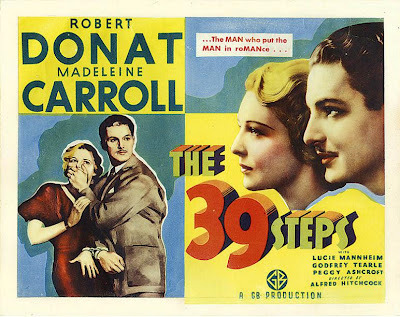
Another Criterion Blu-ray (full review coming soon), this early Hitchcock doesn't reach the heights of the master's later works, but it does point the way to them (especially "North by Northwest") and is a lot of fun to boot. Notice, by the way, that in this vintage poster, Hitch gets a tiny little credit down at the bottom. That wouldn't last long. In fact, this is probably the movie that changed all that.
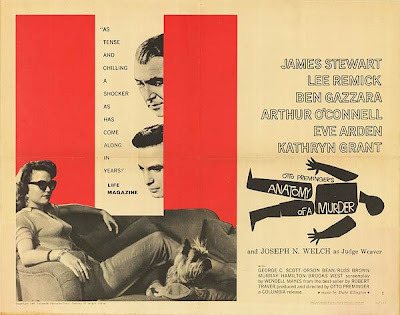
One of my very favorite movies, and one I've seen plenty of times. But what struck me this time is how adult a movie it is for 1959, when the Production Code was still strong and movies were (mostly) very family-oriented. It's not just that the plot revolves around a rape and a murder, but it's the way everyone -- including our hero, Jimmy Stewart -- doesn't care about what really happened so much as they care about swaying a jury. It's more than 2 1/2 hours long but it zips by like lightning, with director Otto Preminger perfectly balancing courtroom drama with laid-back scene setting. The best film on this list this month -- or, probably, any month. If you've never seen it, log off and watch it. Now.
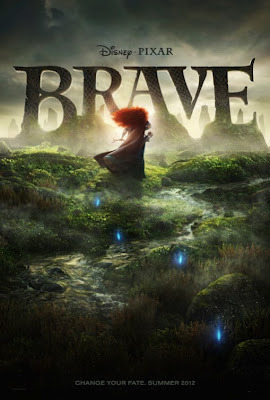
Took Allie to this one and, though it's not the best Pixar movie, it's a nice return to form from "Cars 2." (It's also the Pixar movie that feels the most like a Disney movie, and not just because it revolves around a princess.) It looks great, of course, and has a surprisingly powerful emotional climax. Plus, there's a plot twist that happens about halfway through that I didn't see coming and that takes the movie into a very unusual -- and interesting -- direction.
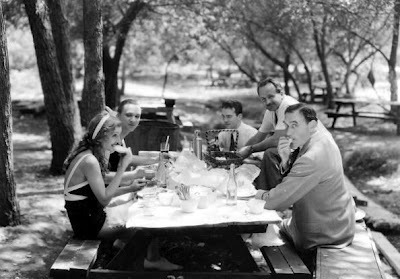
Couldn't find a poster for "Turn Back the Clock," but that shot above is apparently the cast taking a lunch break during filming. It's a 1933 drama starring two of my favorite pre-Code actors, Lee Tracy and Mae Clarke, and focuses on a guy (Tracy) who thinks his lot in life would be better if he'd married the rich guy years ago instead of Clarke. What's fun about "Turn Back the Clock" is that, when Tracy's wish is granted (well, sort of) he uses his knowledge of actual historical events -- World War I, the Great Depression -- to his benefit, making the whole thing a time travel movie (well, sort of). Also, in a wedding scene, three uncredited singers -- who perform no slapstick or comedy, mind you -- are portrayed by none other than Larry, Curly and Moe.
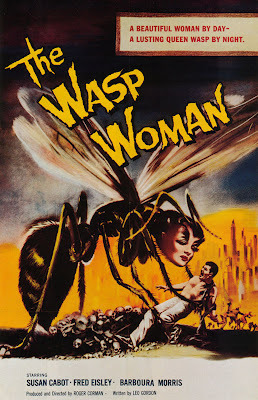
This 1959 Roger Corman directorial effort turned out to be a lot of fun, mostly thanks to its lurid (and ridiculous) plot: Cosmetics tycoon hires scientist to create youth formula from "wasp extract. The movie also has a faux-New York setting, which gives it the vibe of "Mad Men on an extremely low budget." There's no image in the movie even close to the warped brilliance of that poster, but when Susan Cabot does make her big change, it is entertaining in a schlocky, bargain-basement way. Click here to see her face ... if you dare!
Published on July 01, 2012 17:28
June 30, 2012
Will Elder Weekends: Hail to the King!
Here's the first page of Elder and Kurtzman's Elvis spoof from Humbug, "Jailbreak Rock."
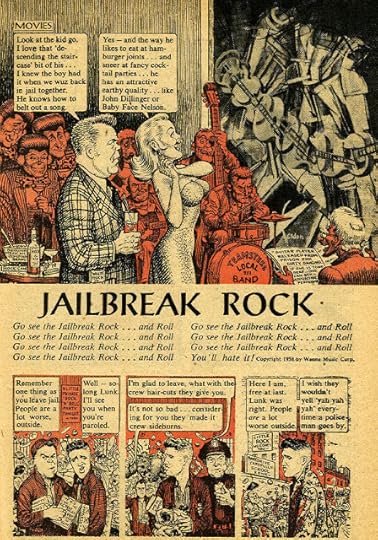
Besides, the bee-yoo-ti-ful linework and dead-on caricatures (love that Elvis sneer in panel 2), there's a great (and pretty sophisticated modern art reference, with Marcel Duchamp's "Nude Descending a Staircase" standing in for the swivel-hipped rocker in the splash. Kurtzman and Elder also included a Duchamp joke in Mad #22, the "Special Art Issue" devoted to "Bill 'Chicken Fat' Elder."
You can get this story -- and many, many more -- in Fantagraphic's swanky two-volume set collecting all the issues of Humbug. The jokes are dated these days (moreso, in fact, than the early Mad comic books), but the art is gorgeous and the restored pages look great. Order it here.

Besides, the bee-yoo-ti-ful linework and dead-on caricatures (love that Elvis sneer in panel 2), there's a great (and pretty sophisticated modern art reference, with Marcel Duchamp's "Nude Descending a Staircase" standing in for the swivel-hipped rocker in the splash. Kurtzman and Elder also included a Duchamp joke in Mad #22, the "Special Art Issue" devoted to "Bill 'Chicken Fat' Elder."
You can get this story -- and many, many more -- in Fantagraphic's swanky two-volume set collecting all the issues of Humbug. The jokes are dated these days (moreso, in fact, than the early Mad comic books), but the art is gorgeous and the restored pages look great. Order it here.
Published on June 30, 2012 18:15
Will Pfeifer's Blog
- Will Pfeifer's profile
- 23 followers
Will Pfeifer isn't a Goodreads Author
(yet),
but they
do have a blog,
so here are some recent posts imported from
their feed.



